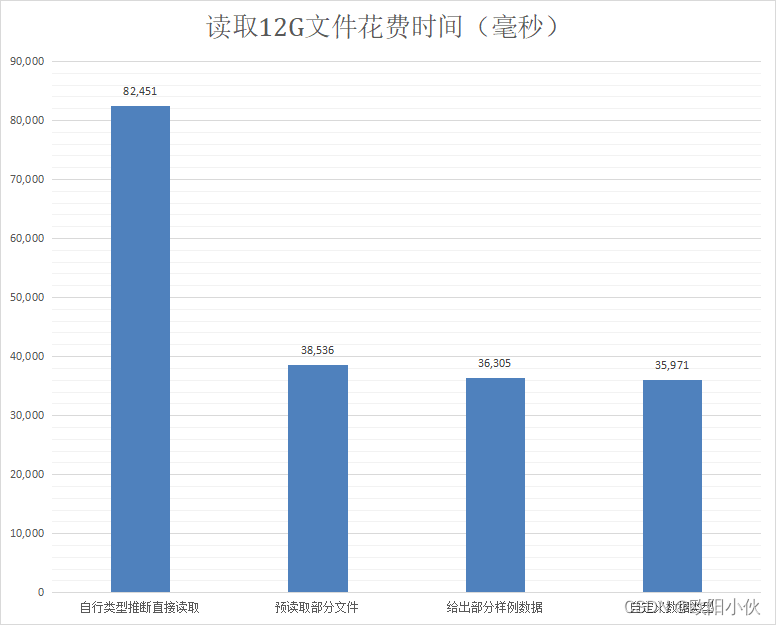Spark读取文件性能优化
在使用spark读取json文件的时候,数据文件有12G,数据读取就耗费了80秒,如果数据量更大,花费时间则更长。后来发现,时间主要浪费在数据读取的时候,类型推断上。为了提高读取速度,可以提前读取小批量的数据获取数据类型模式,然后将类型模式设置给spark的数据读取器,这样在40秒内就读完了所有的数据。
与此同时,可以在代码中写入两条数据,推断出数据类型模式。或者,手动实现数据类型模式。
总之,spark读取数据的时候,不要让它自动推断数据类型,就可以加速数据读取。
0、先看不同的读取文件花费时间对比
1、直接读取数据,spark自行推断数据类型
session
.read
.json(jsonDataPath)
.select($"msg.id.userId" as "userId")
.distinct()
.show(10)
2、为spark的读取器设置数据类型模式
2.1、读取一条数据来获取数据类型的模式
取出一条样例数据,使用spark自动推断出数据类型模式,然后将数据类型设置给spark的读取器。
val sampleData =
"""
|{"version":1,"channel":"8xxxyyyy-uu-3A5","eventId":"FF","otherIds":[],"timestamp":1658257201,"node":"n11","nodeIp":"1.1.1.1","clientIp":"1.2.3.4","clientCountry":"","clientProvince":"","clientIsp":"","msg":{"id":{"wwId":"qwwwwwwwww","userId":"b3dhRQ==","serviceId":"111","stat":5,"credit":{"start":"1970-01-01T00:00:00Z"}},"wwId":"ww","type":3,"version":{"version":"3.11.6","channel":"827A3A5"},"eventNum":1,"events":[{"id":"re_condition1_N","time":"2022-07-19T19:00:00Z","parasNum":2,"paras":[{"key":"sid","value":"233432342"},{"key":"AB","value":"nil"}]}]}}
|""".split('|').map(_.trim).filter(!_.equals(""))
// 读取样例数据
val tempData:RDD[String] = session.sparkContext.parallelize(sampleData)
// 获取数据类型模式
val newSchema2 = session.read.json(tempData).schema
session
.read
.schema(newSchema2) // 将数据类型模式设置给DataFrameReader
.json(jsonDataPath)
.select($"msg.id.userId" as "userId")
.distinct()
.show(10)
2.2、读取一个文件,来获取数据类型模式
// 读取部分样例数据,获取自动推断出的数据类型模式
// sampleDataPath 是一个原来数据文件的一部分
val newSchema = session.read.json(sampleDataPath).schema
session
.read
.schema(newSchema) // 将数据类型模式设置给DataFrameReader
.json(jsonDataPath)
.select($"msg.id.userId" as "userId")
.distinct()
.show(true)
2.3、自定义数据类型模式
自定义数据模式后,然后设置给spark的读取器。其中涉及到基本数据类型,对象类型,数组类型,数组中对象。
// 手动设置相应的类型模式
val newSchema3 = StructType(Array(
StructField("version", LongType),
StructField("timestamp", LongType),
StructField("nodeIp", StringType),
StructField("node", StringType),
StructField("eventId", StringType),
StructField("clientProvince", StringType),
StructField("clientIsp", StringType),
StructField("clientIp", StringType),
StructField("clientCountry", StringType),
StructField("channel", StringType),
StructField("otherIds", ArrayType(StringType, containsNull = true)),
StructField("msg", StructType(Array(
StructField("eventNum", LongType),
StructField("events", ArrayType(StructType(Array(
StructField("id", StringType),
StructField("paras", ArrayType(StructType(Array(
StructField("key", StringType, nullable = true),
StructField("value", StringType, nullable = true)
)), containsNull = true)),
StructField("parasNum", LongType, nullable = true),
StructField("time", StringType, nullable = true)
)), containsNull = true), nullable = true),
StructField("id", StructType(Array(
StructField("credit", StructType(Array(
StructField("start", StringType, nullable = true)
)), nullable = true),
StructField("serviceId", StringType, nullable = true),
StructField("stat", LongType, nullable = true),
StructField("wwId", StringType, nullable = true),
StructField("userId", StringType, nullable = true)
)), nullable = true),
StructField("wwId", StringType, nullable = true),
StructField("type", LongType, nullable = true),
StructField("version", StructType(Array(
StructField("channel", StringType, nullable = true),
StructField("version", StringType, nullable = true)
)), nullable = true)
)), nullable = true)
))
session
.read
.schema(newSchema3) // 将数据类型模式设置给DataFrameReader
.json(jsonDataPath)
.select($"msg.id.userId" as "userId")
.distinct()
.show(5)
3、时间对比
从时间对比可以看出,给数据读取器提前设置数据类型模式,可以将数据读取速度提高一倍。
4、注意
- 对于给出部分数据,让spark提前推断数据类型模式,数据类型要包含全部需要处理的字段,否则会出现找不到字段的异常。
- 可以通过适当调整spark-sumit的参数,增加资源利用率,提高spark执行效率。
- 自定义数据类型模式的时候,需要注意使用的数据类型。
- 这里只是给出了json的读取,csv类型格式也是类似处理方式。
5、自定义数据类型模式
根据官方提供的方法,有多种定义方式。下面的例子可以通过spark的源码中注释中看到。
// 默认添加字段方式,默认字段可以为null
val struct = (new StructType)
.add("a", IntegerType)
.add("b", LongType)
.add("c", StringType)
// 可以添加评论
val struct = (new StructType)
.add("a", IntegerType, true, "comment1")
.add("b", LongType, false, "comment2")
.add("c", StringType, true, "comment3")
// 可以使用字符串类型
val struct = (new StructType)
.add("a", "int")
.add("b", "long")
.add("c", "string")
// 通过StructType的构造方式创建
val innerStruct =
StructType(
StructField("f1", IntegerType, true) ::
StructField("f2", LongType, false) ::
StructField("f3", BooleanType, false) :: Nil)
val struct = StructType(
StructField("a", innerStruct, true) :: Nil)
